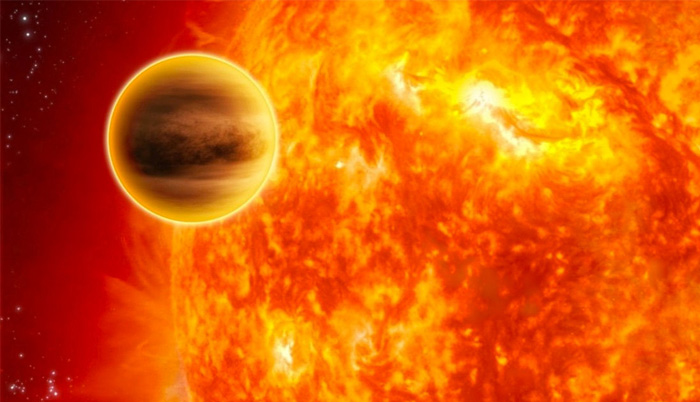![]() Home > Space & Science
Home > Space & Science
Planet Remains Found Scattered Over 'Death Star'

Credit: NASA
![]() December 21st, 2016 | 09:20 AM |
December 21st, 2016 | 09:20 AM | ![]() 1413 views
1413 views
SPACE.COM
A star with a suspicious cocktail of chemicals in its atmosphere has been found and astronomers believe that it's evidence of a planetary murder.
The star, called HIP68468, shares some similarities to our sun and is known to play host to a system of planets. A large gas giant-like planet, approximately 50 percent bigger than Neptune, has been spotted, along with a "super-Earth" world. The super-Earth orbits extremely close to its host star, completing one orbit every three days. But it would appear that there was at least one more planet that used to exist, but has since become stellar toast.
While studying HIP68468, which is located 300 light-years away, the international team of astronomers detected high quantities of lithium in its atmosphere, along with other elements that are associated with rocky planets. By considering the star's age of six billion years, any lithium it formed with would have been long gone, so a fresh batch of lithium must have fallen in recently. Taking into account the observed quantity of lithium and other minerals, the researchers were able to deduce that an entire planet, approximately six times the mass of Earth, likely got consumed by the star in its recent history.
"It's as if we saw a cat sitting next to a bird cage," said Debra Fischer, of Yale University, in a statement. "If there are yellow feathers sticking out of the cat's mouth, it's a good bet that the cat swallowed a canary."
"This study of HIP68468 is a post-mortem of this process happening around another star similar to our sun," she added. "The discovery deepens our understanding of the evolution of planetary systems."
Our solar system may seem to be a stable place, with the planets carving out unchanging orbits. But over the evolution of stars and planets, gravitational instabilities tweak planetary orbits, often causing huge migrations. Migrating planets can have a myriad of effects on other planets, asteroids and comets, and even the stars themselves. In the case of HIP68468, it's thought that an inner planet migrated too close to the superheated furnace and was ultimately consumed by the star.
And using research such as this, we can look at the solar system's planets, perhaps seeing the ultimate demise of planets we know and love. Though Earth can rest easy for now, Mercury, the solar system's innermost planet, might not be so lucky.
"It doesn't mean that the sun will 'eat' the Earth any time soon," said Jacob Bean, from the University of Chicago and co-author of the research to be published in the journal Astronomy & Astrophysics. "But our discovery provides an indication that violent histories may be common for planetary systems, including our own."
Next, the researchers hope to use the Giant Magellan Telescope, which is under construction in Chile, to focus on more sun-like stars to not only detect exoplanets in orbit, but also see what chemicals are floating in the stars' atmospheres to hopefully see more stars that have recently devoured entire planets.
"In addition to finding Earth-like planets, the Giant Magellan Telescope will enable astronomers to study the atmospheric composition of stars at even greater detail than we can today," said Bean. "That will further reveal the histories of planetary systems that are subtly imprinted on their host stars."
Source:
courtesy of SPACE
by Ian O'Neill
If you have any stories or news that you would like to share with the global online community, please feel free to share it with us by contacting us directly at [email protected]